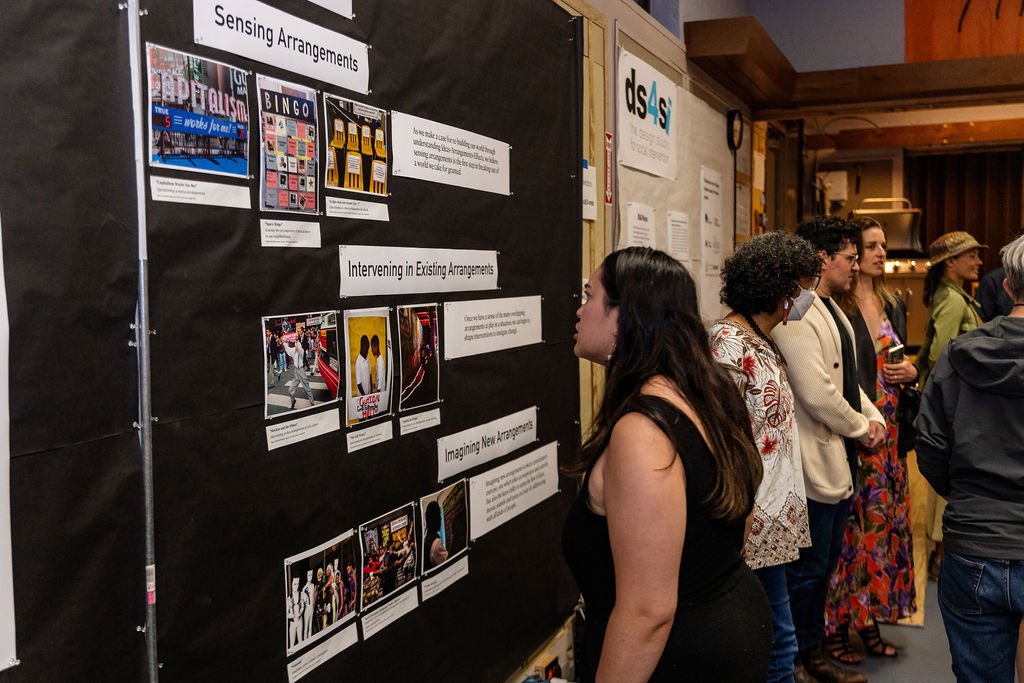
WRITINGS
Expanding Our Range of Motion
In this moment when so many of us are stiff with fear, rigid with rage, and locked into our positions, we at DS4SI suggest considering something counterintuitive. When it feels like we can’t think and we can’t move, we suggest that “can’t think” and “can’t move” are in fact deeply connected. In this moment, instead of the binaries offered to us, we believe we need a range of motion.
Aesthetic Justice Manifesto
We believe that aesthetic justice is essential to the project of life. Even as we fight for our rights to affordable housing, quality education, livable wages, etc., we want to center our right to experience being moved–the shift in affective and emotional registers which bring exhilaration, joy, tears, and connection. We believe the fight for aesthetic justice is a fight for our lives and a fight for a life worth living.
White Chairs and Black Catharsis
Folding chair earrings, Black Aquaman, memes for days—Black people are celebrating the immediate, fubu-style justice meted out in the “Montgomery Brawl.” As Black twitter and insta get busy doing transformative, hilarious, and brilliant culture work, DS4SI co-founder Kenneth Bailey takes a minute to acknowledge the catharsis of Black joy.
Man Attacked by Headlines
On days like today, the headlines stack themselves against me. I get thrown into a particular emotional arc. I am taken up by too familiar a choreography. Something rises in me and that something wants to see a public acknowledgment of what these daily headlines reveal about the daily violence directed at black people.
Imagining Relational Infrastructures
We think communities are essential infrastructures. Infrastructures can be relational; they can be about improving the ways in which communities work and play together to improve quality of public life. We think new infrastructures can be co-designed, built, and managed by communities.
Doing Dishes in a Collapsing Society
The juxtaposition between “everyday time” and societal collapse is undoing us. Giving ourselves a season for collective inquiry and meaning-making is so counter-cultural that just by doing it, we will affect social life.
It happened. Then nothing happened: How do we respond to the absence of response?
How do we collectively reckon with what we saw—and didn’t see— during the attempted coup, when we have no arrangements for stepping out of ordinary time?
Figure/Ground and the Politics of Attention
When attention architects like media outlets and politicians place an intriguing figure in front of us, we need to stop to notice what is being asked of our attention and why. This piece explores figure/ground and what we can learn from artists to blur the lines and grow the frame.
Public Kitchen Zine
Check out this zine full of images (and recipes!) from our first Public Kitchen in Upham’s Corner. It was beautifully laid out by Golden Arrows, the team that also built the mobile kitchen.
Horror is Different Than Terror
For whites, it is critical to understand how horror is different than terror. As we try to talk across race about the endless police and vigilante killings of Black people, we need to explore both horror and terror, and the important gaps between them.
From Enforcers to Guardians
Most public discourse about excessive police violence focuses, understandably, on the horrors of civilian deaths. In From Enforcers to Guardians, Hannah L. F. Cooper and Mindy Thompson Fullilove approach the issue from a radically different angle: as a public health problem.
Click here to read or download PDF.
What We Can Learn From White Terror in 2020
We need to understand that when white lives are at risk, we stop everything. And when black lives are at risk, we stop nothing. Read more.
The Work After Our Rage
Right now, violent ideas about black people are embedded in every arrangement of American society, and the effect is constant black death. DS4SI uses our IAE framework to imagine change.
Ideas-Arrangements-Effects
Ideas are embedded in social arrangements, which in turn produce effects.
Using diverse examples from their work and others, DS4SI offers readers a roadmap for using social interventions to invite the larger public into imagining and creating a more just and vibrant world.
Social Justice in a Time of Social Distancing
Instead of letting the coronavirus amplify and solidify our impulses to individuate, isolate and hunker down into our daily lives, we are making a call for the opposite.
Spatial Justice 2.0: The Zine
Ten short pieces from collaborators explore spatial justice with examples ranging from hostile police sirens as a sonic tool for spatial injustice, to personal reflections on struggles for “black space” (and white flight), to calls for “justice scenographics”, community-led urban planning, and more.
Horizontal Development: Equitable Development for City-Makers
Horizontal development is a way to imagine new forms of city life and new ways for cities to work. This interactive tool we wrote with the University of Orange includes interviews, case studies and activities to engage city dwellers in taking control of development.
The “Five S” Methodology for Designing Effective Social Interventions
Our “5 S’s” include: Structure, System, Scale, Symbol and Sensation. We dig into the “5 S’s” as our first step towards designing effective social interventions.
Public-Making and Spatial Justice
In this short paper we situate what we call public-making—the collective creation and activation of public spaces for interaction and belonging—as a radical, joyful tool for spatial justice. What if we used public space for the collective creation of opportunities for interaction, laughter, dialogue, and surprise?
Do I Know You? A Poem
DS4SI co-founder, Lori Lobenstine, “co-authored” this poem with Judge Timothy J. Wilson after he declared white St. Louis police officer Jason Stockley innocent in the shooting murder of black driver Anthony Lamar Smith. It underscores the dangerous catch-22 of the white carceral/juridical/societal gaze on the black body.




















